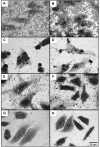Surveillance of Diarrheagenic Escherichia coli Strains Isolated from Diarrhea Cases from Children, Adults and Elderly at Northwest of Mexico
- PMID: 27965648
- PMCID: PMC5127799
- DOI: 10.3389/fmicb.2016.01924
Surveillance of Diarrheagenic Escherichia coli Strains Isolated from Diarrhea Cases from Children, Adults and Elderly at Northwest of Mexico
Abstract
Diarrheagenic Escherichia coli (DEC) strains are a main cause of gastrointestinal disease in developing countries. In this study we report the epidemiologic surveillance in a 4-year period (January 2011 to December 2014) of DEC strains causing acute diarrhea throughout the Sinaloa State, Mexico. DEC strains were isolated from outpatients of all ages with acute diarrhea (N = 1,037). Specific DEC pathotypes were identified by PCR-amplification of genes encoding virulence factors. The adhesion phenotype and antibiotic resistance were also investigated. DEC strains were detected in 23.3% (242/1037) of cases. The most frequently DEC strain isolated was EAEC [(12.2%), 126/242] followed by EPEC [(5.1%), 53/242], ETEC [(4.3%), 43/242] DAEC [(1.4%), 15/242], STEC [(0.3%), 3/242], and EIEC [(0.2%), 2/242]. EHEC strains were not detected. Overall DEC strains were more prevalent in children ≤2 years of age with EPEC strains the most common of DEC pathotypes. While ∼65% of EAEC strains were classified as typical variant based on the aggregative adherence to in vitro cultures of HEp-2 cells, a high proportion of EPEC strains was classified as atypical strains. EAEC, EPEC, ETEC, and DAEC strains were distributed in the north, central and south regions of Sinaloa state. Among all DEC strains, >90% were resistant to at least one commonly prescribed antibiotic. Strains were commonly resistant to first-line antibiotics such as tetracycline, ampicillin, and sulfamethoxazole-trimethoprim. Furthermore, more than 80% of DEC isolates were multi-drug resistant and EPEC and DAEC were the categories with major proportion of this feature. In conclusion, in nearly one out of four cases of acute diarrhea in Northwestern Mexico a multi-drug resistant DEC strain was isolated, in these cases EAEC was the most prevalent (52%) pathotype.
Keywords: antibiotic resistance; biosurveillance; diarrhea; diarrheagenic E. coli; pathotypes.
Figures


Similar articles
-
Prevalence and antibiotic resistance profiles of diarrheagenic Escherichia coli strains isolated from food items in northwestern Mexico.Int J Food Microbiol. 2013 Jun 3;164(1):36-45. doi: 10.1016/j.ijfoodmicro.2013.03.020. Epub 2013 Mar 27. Int J Food Microbiol. 2013. PMID: 23587712
-
Antibiotic resistance and virulence patterns of pathogenic Escherichia coli strains associated with acute gastroenteritis among children in Qatar.BMC Microbiol. 2020 Mar 6;20(1):54. doi: 10.1186/s12866-020-01732-8. BMC Microbiol. 2020. PMID: 32143566 Free PMC article.
-
Diarrheagenic Escherichia coli pathotypes frequency in Khuzestan province of Iran.Iran J Microbiol. 2016 Dec;8(6):352-358. Iran J Microbiol. 2016. PMID: 28491244 Free PMC article.
-
An overview of diarrheagenic Escherichia coli in Iran: A systematic review and meta-analysis.J Res Med Sci. 2019 Mar 25;24:23. doi: 10.4103/jrms.JRMS_256_18. eCollection 2019. J Res Med Sci. 2019. PMID: 31007693 Free PMC article. Review.
-
Prevalence of Multidrug-Resistant Diarrheagenic Escherichia coli in Asia: A Systematic Review and Meta-Analysis.Antibiotics (Basel). 2022 Sep 29;11(10):1333. doi: 10.3390/antibiotics11101333. Antibiotics (Basel). 2022. PMID: 36289991 Free PMC article. Review.
Cited by
-
Comparative Analysis of Human and Animal E. coli: Serotyping, Antimicrobial Resistance, and Virulence Gene Profiling.Antibiotics (Basel). 2022 Apr 21;11(5):552. doi: 10.3390/antibiotics11050552. Antibiotics (Basel). 2022. PMID: 35625196 Free PMC article.
-
Diarrheagenic Escherichia coli in Costa Rican children: a 9-year retrospective study.BMC Res Notes. 2019 May 28;12(1):297. doi: 10.1186/s13104-019-4313-1. BMC Res Notes. 2019. PMID: 31138269 Free PMC article.
-
Drug Susceptibility Testing and Synergistic Antibacterial Activity of Curcumin with Antibiotics against Enterotoxigenic Escherichia coli.Antibiotics (Basel). 2019 Apr 18;8(2):43. doi: 10.3390/antibiotics8020043. Antibiotics (Basel). 2019. PMID: 31003468 Free PMC article.
-
A study of virulence and antimicrobial resistance pattern in diarrhoeagenic Escherichia coli isolated from diarrhoeal stool specimens from children and adults in a tertiary hospital, Puducherry, India.J Health Popul Nutr. 2018 Jul 13;37(1):17. doi: 10.1186/s41043-018-0147-z. J Health Popul Nutr. 2018. PMID: 30005599 Free PMC article.
-
Intestinal and Extraintestinal Pathotypes of Escherichia coli Are Prevalent in Food Prepared and Marketed on the Streets from the Central Zone of Mexico and Exhibit a Differential Phenotype of Resistance Against Antibiotics.Antibiotics (Basel). 2025 Apr 16;14(4):406. doi: 10.3390/antibiotics14040406. Antibiotics (Basel). 2025. PMID: 40298585 Free PMC article.
References
-
- Amisano G., Fornasero S., Migliaretti G., Caramello S., Tarasco V., Savino F. (2011). Diarrheagenic Escherichia coli in acute gastroenteritis in infants in North-West Italy. New Microbiol. 34 45–51. - PubMed
LinkOut - more resources
Full Text Sources
Other Literature Sources
Molecular Biology Databases
Research Materials

